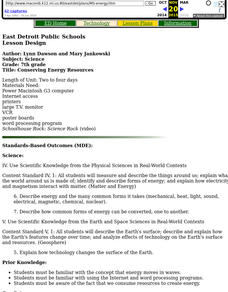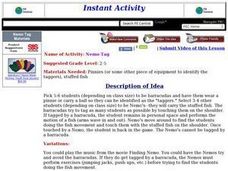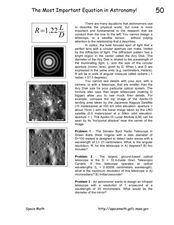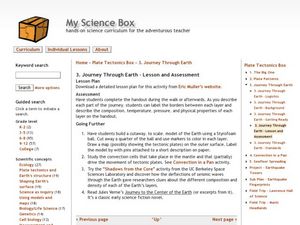Curated OER
The Science of Weather: Hurricanes
Learners use this USA today activity to learn about hurricane season. In this hurricane lesson, students study the map of the earth and hurricane science. Learners complete discuss questions. Students draw a map of the United States and...
Curated OER
Chemistry: Classifying Materials
Students classify materials. In this chemistry lesson, students examine the properties of solids, liquids, and gases. Students discover the elements, compounds, and chemical symbols.
Curated OER
Magnetic Discovery Bottle
Students examine how to conduct simple investigations and use simple equipment to gather data. For this magnet lesson students decide what types of objects are attracted to magnets.
Curated OER
Rube Goldberg Project
Students apply inquiry and problem solving approaches in science. They design a device (invention) that solves a special problem.
Curated OER
Postcards from California: A Unit on Geography, Social Studies, History and California's Resources
Fourth graders examine patterns that influence population density in the various regions of California. The unit's three lessons utilize graphic organizers for the interpretation and presentation of data.
Curated OER
Make a Sound Viewer
Pupils see, and thus better understand, the vibrations that sound makes through this simple project.
Curated OER
Men in Black Line Dance
Students practice and perform a line dance to Smith's song Men in Black.
Curated OER
Conserving Energy Resources
Seventh graders research on energy conversion. After they have researched several types of energy resources, teams of two to four create posters which depict how these resources can be conserved.
Curated OER
Gold Mountain
Young scholars read primary and secondary sources to find jobs as a Chinese immigrant. In groups they create a chart listing jobs for Chinese and write a letter about employment and living conditions to a Chinese friend.
Curated OER
Lumini Stick Macarena
Students use lummi sticks to perform a routine and identify a rhythmical beat.
Curated OER
Dinnertime On The Reef
Learners identify the main parts of a coral reef. They describe a coral reef food chain.
Curated OER
The Immigrant Experience
Students utilize oral histories to discover, analyze, and interpret immigration and migration in the history of the United States. A goal of the unit is fostering a discussion and encouraging students to make meaning of the bigger...
Curated OER
Regolith Formation
Students compare and contrast the process of regolith formations. In groups, students define regolith and discover how regolith is formed on the Earth and on the Moon. They participate in experimental activities to simulate regolith.
Curated OER
Vibration and Pitch
Fifth graders investigate the relation between vibrations and pitch. They observe and discuss an experiment involving a bicycle and a piece of cardboard in the spokes, listen to a comb with cardboard, and listen to various sounds and...
Curated OER
Alligator
Pupils investigate the musical concept of rhythm through the use of creating a beat. The beat must have a specific and purposeful rhythm. Student can then define the term of rhythm easier after performing the activity.
Curated OER
Alligator
Young scholars perform musical routines with lummi sticks and motions. As they hit the sticks together in time to the music, students move the sticks over their head, sit on their knees, lay on their tummy, on their side, and on their...
Curated OER
Nemo Tag
Students participate in tag games to exercise. They are divided into two groups: barracudas and Nemo fish. Barracudas tag as many students as possible. Once tagged,t he students perform fish motions, in place, until a "Nemo" touches...
Curated OER
The Most Important Equation in Astronomy!
For this astronomy optics worksheet, students calculate the angular resolution and maximum resolution for given telescope specifics. This worksheet has 3 problems to solve.
Curated OER
Shackleton's Antarctic Adventure
Students research the exploration of Antarctica by the explorer Sir Ernest Shackelton. In this Antarctic exploration lesson, students watch a movie about Sir Ernest Shackelton and his ship the Endurance. Students study a map of...
Curated OER
Journey Through Earth
Students study plate tectonics. In this plate tectonics lesson students build a cutaway scale model of the Earth.
Curated OER
Retell A Story Through Dance
Students tell stories through dance. In this ballet lesson, students learn pantomime dance skills and examine "The Nutcracker" ballet performances as they examine ballet as storytelling.
Curated OER
The Day the Atom Died (Grade K-1)
Young scholars investigate what is wrong with the Rutherford atomic model. In this chemistry lesson, students answer questions about the atomic model after watching a video. They draw conclusions from the video and discuss how the atomic...
Curated OER
Sonar and Marine Mammals
In this marine science worksheet, students study online reports and data on sonar effects on marine animals. They complete 7 short answer questions that follow.
Curated OER
The Connection Between Pigment and Light Colors
Students learn the procedure for mixing secondary colors from primary pigments and observe the results of mixing two primary colors.

























